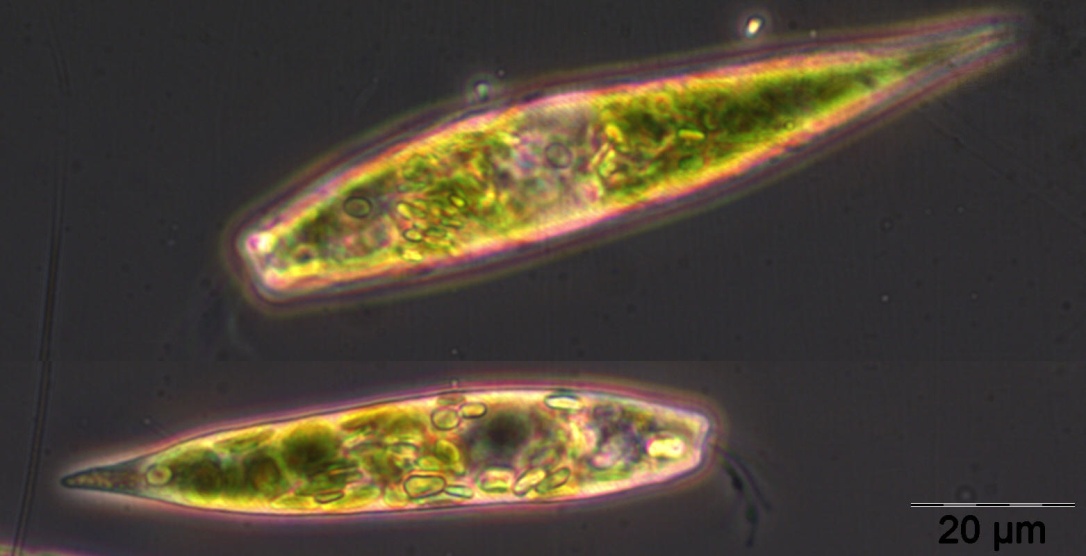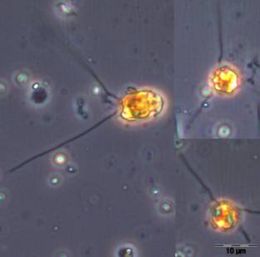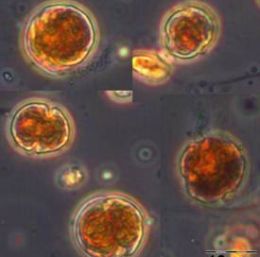
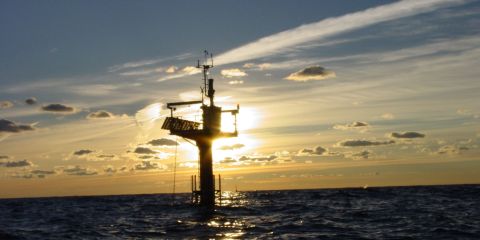
Phytoplankton development at the coastal station "Seebrücke Heiligendamm" in 2011
The Leibniz Institute for Baltic Sea Research conducts a coastal monitoring programme with weekly samplings at the sea-bridge Heiligendamm (54°08,55' N; 11°50,60' E; 300 m off shore, 3 m water depth). The Department of Marine Biology analyses the surface samples, taken by means of a bucket, for phytoplankton composition and biomass and for chlorophyll a.
The phytoplankton biomass is determined by microscopical counting (UTERMÖHL method) and the chlorophyll a concentration by ethanol extraction and fluorometric measurement. Method instructions see http://www.helcom.fi/groups/monas/CombineManual/AnnexesC/en_GB/.
Phytoplankton counting was carried through by use of the counting programme OrgaCount and is based on the HELCOM-biovolume factors which are annually updated: http://www.ices.dk/env/repfor/index.asp (basics see in Olenina et al. 2006). The analytical specifics of the chlorophyll a determination are published by Wasmund et al. (2006). According to the decision of the BLMP-subgroup “Quality Assurance” from 11.9.2008 we show here chlorophyll a data which are not corrected for pheopigments.
Microscopical analysis was not possible in samples containing high sediment portions, caused by wind-induced sediment resuspension at the shallow station. It seems that the share of sediment-containing samples increased, probably because of diminishing water depth. Sampling was completely impossible on 8 February, 8 August and 8 November 2011.
The results are shown in Fig. 1
As expected, phytoplankton biomass stayed low in the cold month of January 2011. In the first weeks, diatoms (Diatomophycee) of the genus Actinocyclus sp. dominated, followed by a growth of Mesodinium rubrum. On 1.2.2011 (week 5), Eutreptiella braarudii) appeared (Image 1), but it disappeared after the storm event.
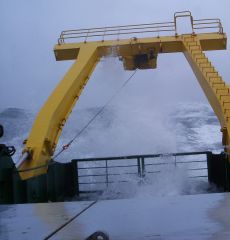
State of the Baltic Sea
- Annual Reports on the state of the Baltic Sea Environment
- Cruise Reports
- Data from the autonomous measuring stations
- Development of the suboxic and anoxic regions since 1969
- Baltic Thalweg transect since 2014
- Algal blooms at Heiligendamm since 1998
- "Major Baltic Inflow" December 2014
- "Major Baltic Inflow" January 2003
- Baltic saline barotropic inflows 1887 - 2018
- Further Reading
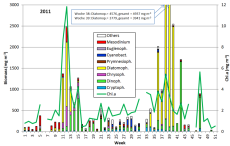
Until 8.3.2011 (week 10), phytoplankton biomass stayed low. We have to admit that the samples contained much sand grains which impair the microscopical counting results. However, the low chlorophyll-a-concentrations confirm our phytoplankton data. Within the diatoms, Rhizosolenia setigera dominated in weeks 8 and 9 and Achnanthes taeniata in week 10.
The spring bloom started on 15.3.2011(week 11) which is one week later than in the previous year. At the time of its maximum (on 22.3.2011) it was dominated by Achnanthes taeniata (654 mg m-3, see Image 2), Detonula confervacea (472 mg m-3, see Image 3) and Chaetoceros spp. (212 mg m-3). Skeletonema costatum and the Euglenophycee Eutreptiella sp. were astonishingly low in this spring bloom in comparison with that of the year 2010. Instead, Dictyocha speculum (Image 4) occurred with a biomass up to 388 mg m-3, predominantly in its naked form. This species was counted to Chrysophyceae in Fig.1 and accounts for approximately 80% in this group. It belongs to the common spring plankton, but it was exceptionally low in 2010.
The diatom bloom decreased quickly, and the so far dominating groups (diatoms as well as the species Dictyocha speculum and Mesodinium rubrum) were successively replaced by dinoflagellates (Peridiniales, frequently Peridiniella danica, Image 5). Besides of these, Dictyocha speculum appeared again on 12.4.2011 (week 15) with high biomass.
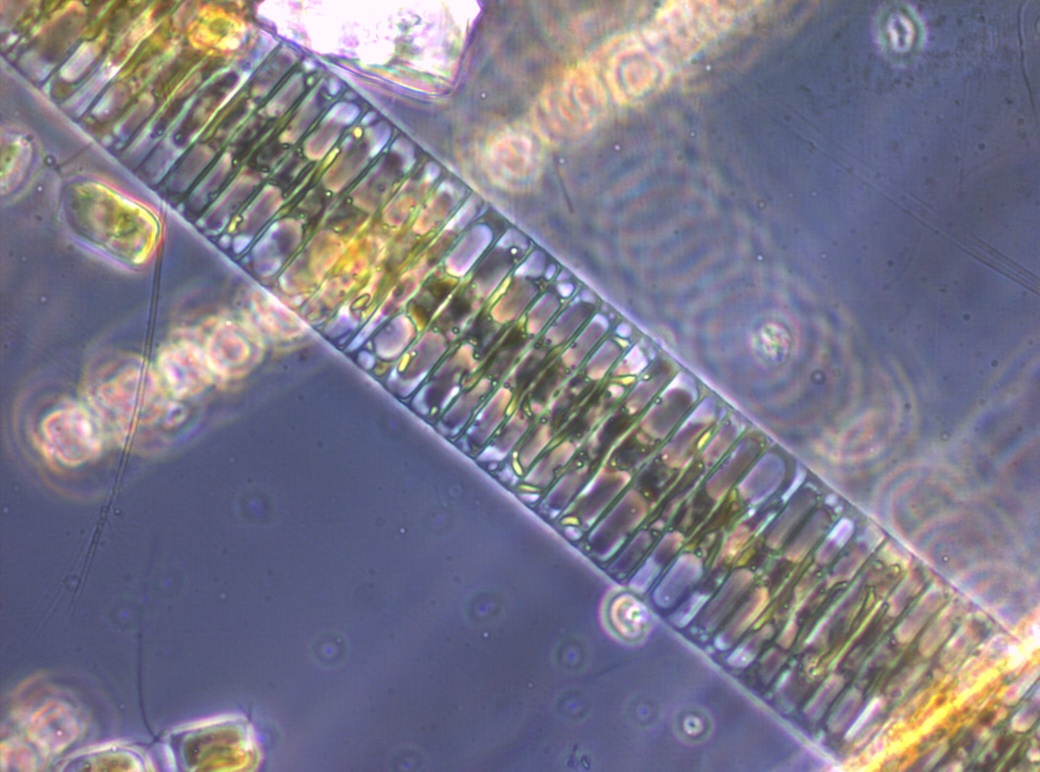
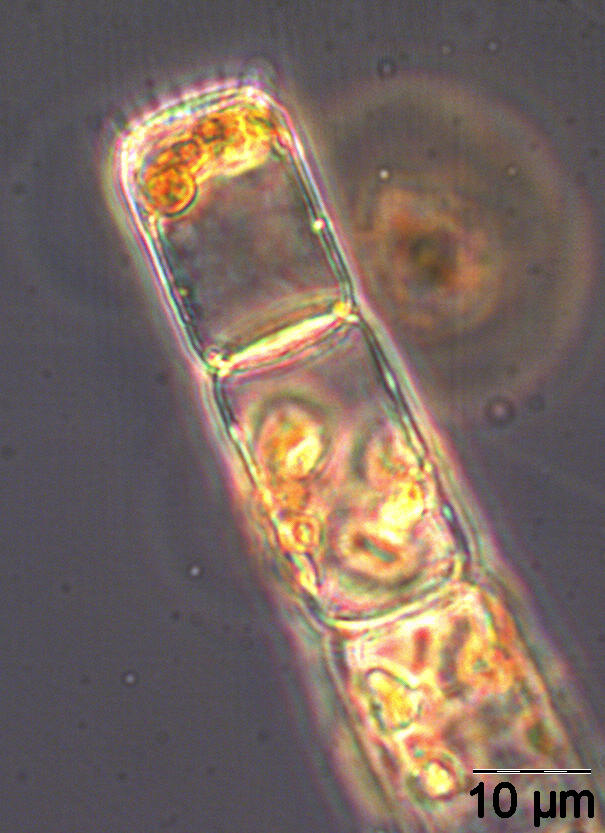
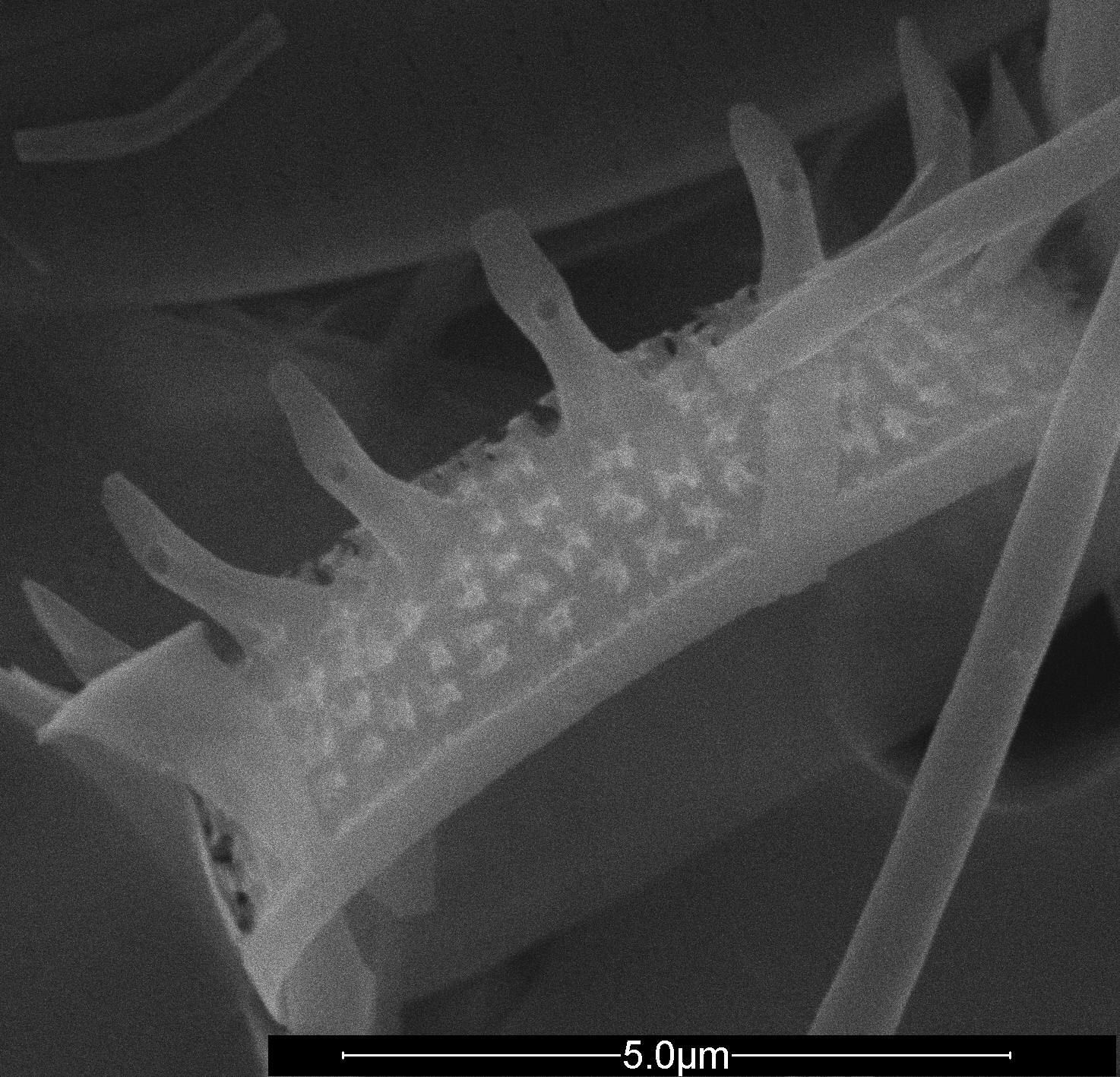
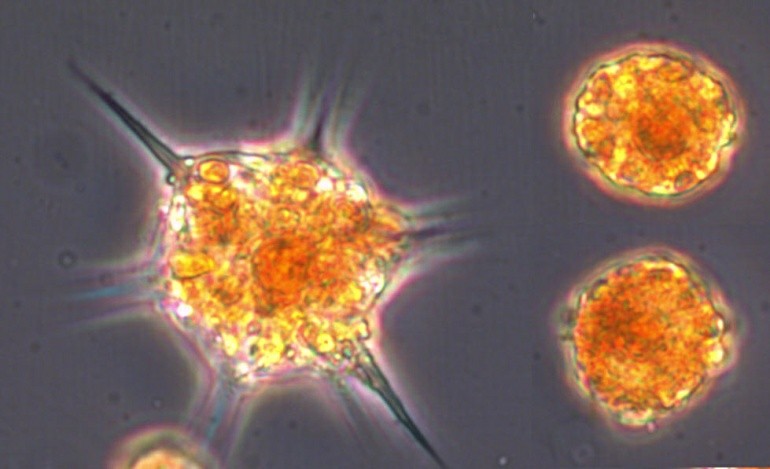
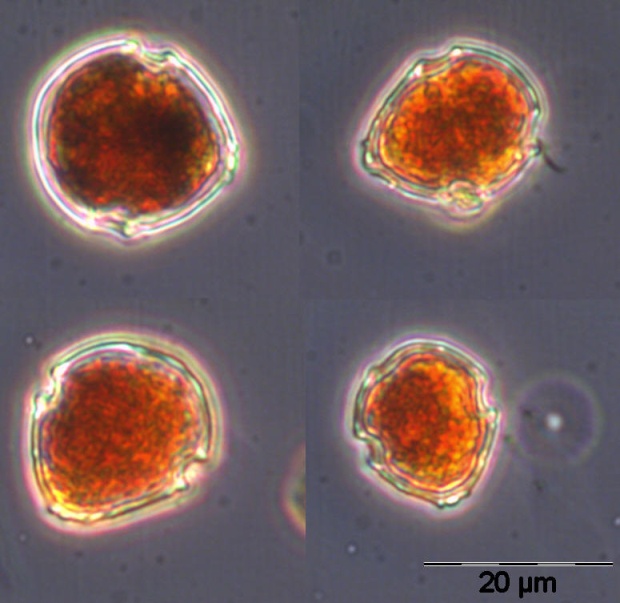
A succession from diatoms to dinoflagellates within the spring bloom is rather common in the western Baltic Sea. The spring bloom was terminated by the 19.4.2011 (Week 16).
After the conspicuous phytoplankton spring bloom, biomass and chlorophyll a concentrations stayed low during the summer (until 30.8.2011, =week 35). On 3.5.2011 (week 18), Chrysochromulina spp. (Image 6) and unidentified Gymnodiniales (Image 7) dominated. Gymnodiniales tend to increase until 24.5.2011 (week 21). Afterwards they disappeared, but Cryptophyceae (Plagioselmis, Hemiselmis, Teleaulax) grew slightly and by week 23 also Chrysochromulina spp.
Since 14.6.2011 (Week 24), Cyanobacteria appeared: Aphanocapsa sp., Snowella sp., Pseudanabaena limnetica, Aphanothece sp., Aphanizomenon sp. The phytoplankton kept a high diversity throughout the summer. For example on 12.7.2011 (Week 28), besides the above mentioned Chrysochromulina spp. and Gymnodiniales, also the dinoflagellate Alexandrium pseudogonyaulax (58 mg/m³, Image 8) and the Cyanobacterium Aphanizomenon sp. (49 mg/m³, Image 9) became important.
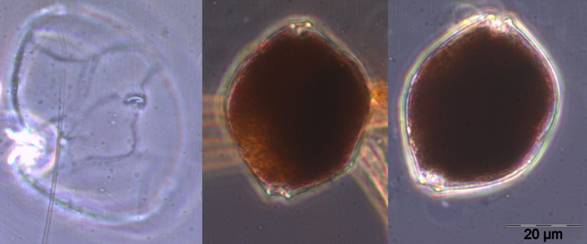
Image 8: Alexandrium pseudogonyaulax
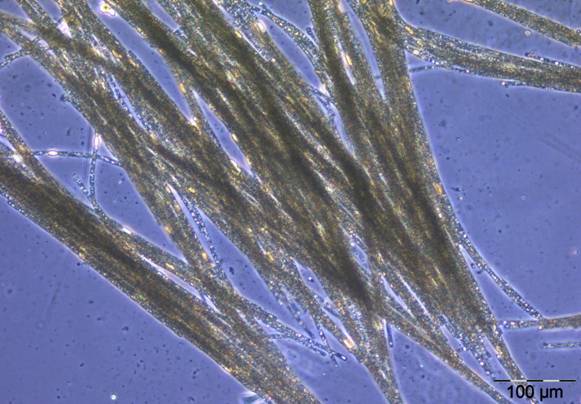
Image 9: Aggregate of filaments of Aphanizomenon sp.
On 19.7.2011, the Cyanobakterium Nodularia spumigena became present. On 1.8.2011, Prorocentrum minimum was dominant with 58 mg/m³. By the16.8.2011 (week 33), Cyanobacteria disappeared and the dinoflagellate Ceratium tripos appeared.
On 23.8.2011 (Week 34), a strong diatom development started with the growth of Cerataulina pelagica (Image 10) and Dactyliosolen fragilissimus (Image 11).
Biomass on 30.8.2011 is strongly underestimated because of wind-induced resuspension of sedimented particles which made the quantitative microscopical analysis improper.
On 6.9.2011, Cerataulina pelagica was suddenly absent, but Dactyliosolen fragilissimus had developed strongly (1057 mg/m³). Still stronger was the growth of Pseudosolenia calcar-avis (1704 mg/m³). The two last-mentioned species stayed the dominating species until 27.9.2011 (week 39).
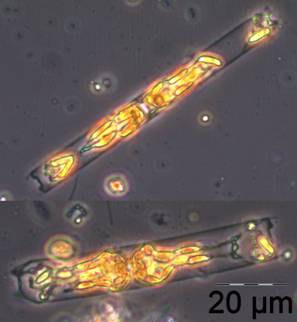
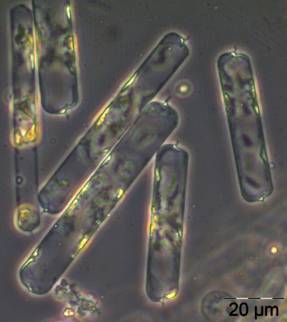
Cerataulina pelagica developed again, and with lower intensity also the diatoms Proboscia alata, Rhizosolenia pungens, Thalassionema nitzschioides as well as the dinoflagellates Prorocentrum micans and Prorocentrum minimum. The bloom has reached its peak on 20.9.2011 (week 38) with a biomass of 4937 mg/m³. It diminished by the 4.10.2011 (week 40) clearly, particularly by a decrease in Pseudosolenia calcar-avis. The sample from 11.10.2011 could not be analysed quantitatively because of disturbing sediment particles, but is nevertheless presented in Fig. 1 in order to show the dinoflagellates have suddenly replaced the diatoms. On 18.10.2011 (week 42), a strong bloom of Ceratium tripos (Image 12) was noticed. After a 4-weeks interruption, it was still present on 22.11.2011 (week 47). The following samples could not be analysed quantitatively.
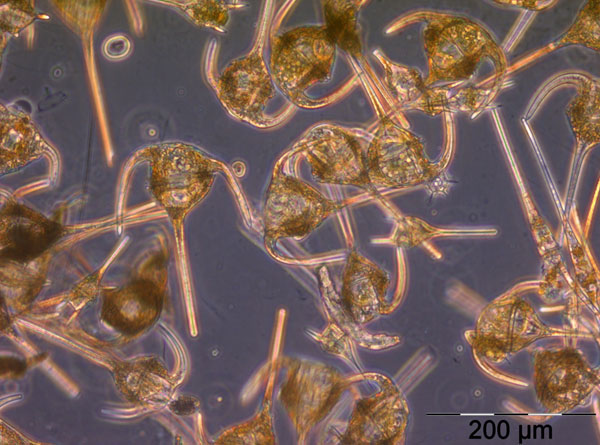
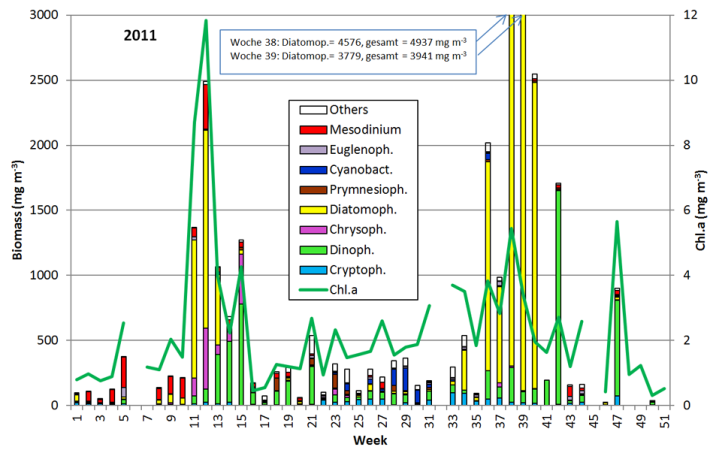
References:
Olenina, I., Hajdu, S., Andersson, A.,Edler, L., Wasmund, N., Busch, S., Göbel, J., Gromisz, S., Huseby, S., Huttunen, M., Jaanus, A., Kokkonen, P., Ledaine, I., Niemkiewicz, E. (2006): Biovolumes and size-classes of phytoplankton in the Baltic Sea. Baltic Sea Environment Proceedings No.106, 144pp.
http://www.helcom.fi/stc/files/Publications/Proceedings/bsep106.pdf
Wasmund, N., Topp, I., Schories, D. (2006): Optimising the storage and extraction of chlorophyll samples. Oceanologia 48: 125-144.
Dr. Norbert Wasmund,
Susanne Busch,
Ina-Marie Topp,
Regina Hansen
____________________________________________________________________________________________________________
Leibniz Institute für Ostseeforschung Warnemünde (IOW), Seestr. 15,
D-18119 Rostock-Warnemünde
Corresponding author: norbert.wasmund@io-warnemuende.de
All photos taken by Susanne Busch.
